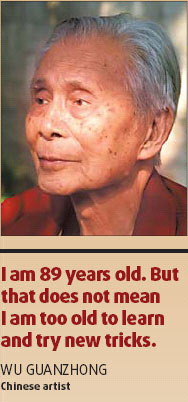Three years later, upon the founding of New China, Wu returned to Beijing and became an art educator.
 However, as Wu reached his artistic peak in his 40s, the "cultural revolution (1966-76)" erupted.
However, as Wu reached his artistic peak in his 40s, the "cultural revolution (1966-76)" erupted.
Wu was forbidden from all artistic creation until 1972; at 53, he was allowed to paint one day a week.
He then did a dozen famous oil paintings depicting rural life, while he was farming in North China's Hebei province, using paperboard instead of canvas, and a manure basket as his table.
When Wu returned to Beijing in 1973, he discovered his courtyard room was too small for oil painting.
This inspired the artist to develop a new method of ink-and-wash painting.
"Wu has always been ready to challenge conventional ideas and is respected by many for his constant search for artistic expressions that best suits his inner feelings," Li says.
An eclectic artist who has tried to merge ideas from East and West, Wu has created a body of work that is appreciated by both Chinese and Europeans.
Wu says that this cross-cultural fascination was sparked by his mixed educational background.
"Elements of Chinese and Western art are bound to clash in my mind," Wu says.
For many, Chinese and Western paintings are diametrically opposed to each other. However, Wu sees it differently.